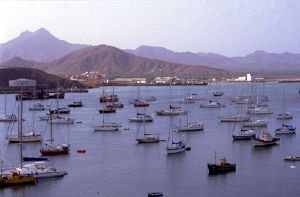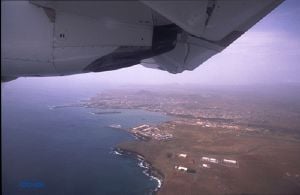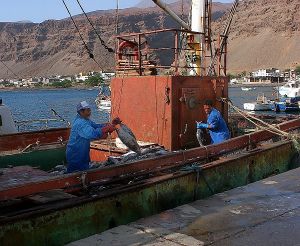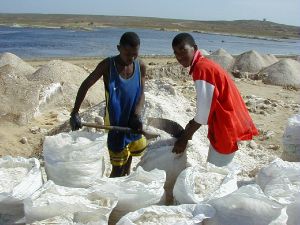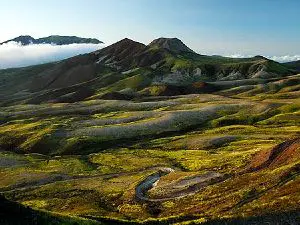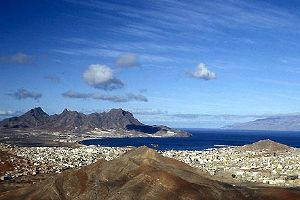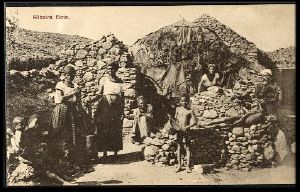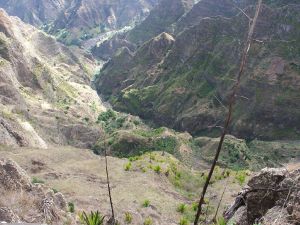Difference between revisions of "Cape Verde" - New World Encyclopedia
John Willis (talk | contribs) (created, categorized, and credited) |
John Willis (talk | contribs) (moved geog. paragraph) |
||
| Line 2: | Line 2: | ||
[[Category:Countries]] | [[Category:Countries]] | ||
| − | The '''Republic of Cape Verde''' or '''Cape Verde''' | + | The '''Republic of Cape Verde''' or '''Cape Verde''' is a [[republic]] located on an [[archipelago]] in the [[Macaronesia]] [[ecoregion]] of the North [[Atlantic Ocean]], off the western coast of [[Africa]]. The previously-uninhabited islands were discovered and colonized by the Portuguese in the 15th century; they subsequently became a trading centre for African [[slavery|slaves]]. Most Cape Verdeans descend from both groups. |
"Cape Verde" is named for [[Cap-Vert]], now in [[Senegal]], the westernmost point of Africa. | "Cape Verde" is named for [[Cap-Vert]], now in [[Senegal]], the westernmost point of Africa. | ||
| Line 71: | Line 71: | ||
| 238 | | 238 | ||
|} | |} | ||
| − | |||
| − | |||
| − | |||
| − | |||
| − | |||
| − | |||
| − | |||
| − | |||
| − | |||
| − | |||
| − | |||
| − | |||
| − | |||
| − | |||
| − | |||
| − | |||
| − | |||
| − | |||
| − | |||
| − | |||
== Geography == | == Geography == | ||
| − | |||
| − | |||
| − | Cape Verde is an | + | Cape Verde is an archipelago off the coast of Africa. It is formed by 10 main islands and about 8 islets. The main islands are: |
*[[Barlavento]]s (northern island group) | *[[Barlavento]]s (northern island group) | ||
| Line 110: | Line 88: | ||
**[[Brava, Cape Verde|Brava]] | **[[Brava, Cape Verde|Brava]] | ||
| − | Of these, only Santa Luzia is uninhabited. Presently it is a Natural Reserve. All islands are volcanic, but an active volcano exists on one of the islands, Fogo | + | Of these, only Santa Luzia is uninhabited. Presently it is a Natural Reserve. All islands are volcanic, but an active volcano exists on one of the islands, Fogo. |
The islets are [[Branco, Cape Verde|Branco]], [[Razo]]. | The islets are [[Branco, Cape Verde|Branco]], [[Razo]]. | ||
| − | + | [[Image:CapeVerde.png|right]] | |
[[Image:CapeVerdeIslands.jpg|thumb|An aerial view of Cape Verde]] | [[Image:CapeVerdeIslands.jpg|thumb|An aerial view of Cape Verde]] | ||
[[Image:Mindelo portogrande.jpg|thumb|Porto Grande - the harbour of Mindelo, Sao Vicente Island]] | [[Image:Mindelo portogrande.jpg|thumb|Porto Grande - the harbour of Mindelo, Sao Vicente Island]] | ||
[[Image:Praia aerialview.jpg|thumb|An aerial view of the capital Praia]] | [[Image:Praia aerialview.jpg|thumb|An aerial view of the capital Praia]] | ||
| − | |||
| − | + | == History == | |
| − | + | ||
| − | + | Cape Verde was uninhabited when the Portuguese arrived in 1456, and the islands were thus made part of the Portuguese empire. Due to its location off the coast of [[Africa]], Cape Verde became an important port, and was a major center of the slave trade. | |
| − | + | ||
| − | + | In 1975, the islands achieved independence, partially due to the efforts of the African Party for the Independence of Guinea-Bissau and Cape Verde ([[Partido Africano da Independência da Guiné e Cabo Verde|PAIGC]]). After independence, the PAIGC attempted to unite Cape Verde and [[Guinea-Bissau]] into one nation, the PAIGC controlling both governments, but a coup in the latter nation in 1980 ended these plans. In Cape Verde itself the PAICV (affiliated with the PAIGC) governed until elections were held in 1991 that resulted in a change of government. The PAICV was re-elected in 2001. | |
| − | + | ||
| − | + | == Politics == | |
| − | + | ||
| − | + | The government of Cape Verde is based on a Constitution that was established in [[1980]]. Elections are held for both the [[Prime Minister]] and [[President]], who both govern for 5-year terms. Members of the General Assembly are elected as well, and they appoint the Supreme Court along with the President and Prime Minister. | |
| − | |||
| − | |||
| − | |||
| − | |||
| − | |||
| − | |||
| − | |||
| − | |||
| − | |||
| − | |||
| − | |||
| − | |||
| − | |||
| − | |||
| − | |||
| − | |||
| − | |||
| − | |||
| − | |||
| − | |||
| − | |||
| − | |||
| − | |||
== Economy == | == Economy == | ||
| − | + | ||
[[Image:Pecheurs tarrafal.jpg|thumb|fishermen in Cape Verde]] | [[Image:Pecheurs tarrafal.jpg|thumb|fishermen in Cape Verde]] | ||
[[Image:Sea-salt-minemaio.jpg|thumb|sea salt mine in Cape Verde]] | [[Image:Sea-salt-minemaio.jpg|thumb|sea salt mine in Cape Verde]] | ||
| Line 160: | Line 114: | ||
[[Image:Sao Vicente.jpg|thumb|Sao Vicente, Cape Verde]] | [[Image:Sao Vicente.jpg|thumb|Sao Vicente, Cape Verde]] | ||
| − | Cape Verde is a small nation that lacks resources and has experienced severe droughts as well as water shortages. Agriculture is somewhat stymied by lack of rain, and is restricted to only four islands for most of the year. Most of the nation's GDP is from the services industry. Cape Verde's economy has largely grown since the late 1990s, and is now considered a country of average human development. Cape Verde has significant cooperation with Portugal at every level of the economy, leading it to fix its currency, firstly through the Portuguese escudo, then the [[Euro]] since | + | Cape Verde is a small nation that lacks resources and has experienced severe droughts as well as water shortages. Agriculture is somewhat stymied by lack of rain, and is restricted to only four islands for most of the year. Most of the nation's GDP is from the services industry. Cape Verde's economy has largely grown since the late 1990s, and is now considered a country of average human development. Cape Verde has significant cooperation with Portugal at every level of the economy, leading it to fix its currency, firstly through the Portuguese escudo, then the [[Euro]] since 1999. |
| − | Former Portuguese prime minister [[José Manuel Durão Barroso]], now (second semester | + | Former Portuguese prime minister [[José Manuel Durão Barroso]], now (second semester 2004) president of the European Commission, has promised to help integrate Cape Verde within the European Union sphere of influence via greater cooperation with Portugal. In March 2005, former Portuguese president [[Mário Soares]] launched a petition urging the European Union to start membership talks with Cape Verde. |
== Demographics == | == Demographics == | ||
| − | |||
| − | |||
Most inhabitants of Cape Verde are descendants of the white Portuguese settlers and black African slaves. More Cape Verdeans live abroad than in Cape Verde, with significant emigrant Cape Verdean communities in the [[United States]] (264,900 Cape Verdians), [[Portugal]] (80,000) and [[Angola]] (45,000). There are also significant number of Cape Verdeans in [[São Tomé and Príncipe]], [[Senegal]], [[France]] and the [[Netherlands]]. | Most inhabitants of Cape Verde are descendants of the white Portuguese settlers and black African slaves. More Cape Verdeans live abroad than in Cape Verde, with significant emigrant Cape Verdean communities in the [[United States]] (264,900 Cape Verdians), [[Portugal]] (80,000) and [[Angola]] (45,000). There are also significant number of Cape Verdeans in [[São Tomé and Príncipe]], [[Senegal]], [[France]] and the [[Netherlands]]. | ||
== Culture == | == Culture == | ||
| − | |||
The culture of Cape Verde reflects its mixed Portuguese and African roots. It is well known for its diverse forms of music such as [[Morna]] (the Capeverdian [[Fado]]) and the urban Cape Verdian [[kizomba]], and a wide variety of dances: the soft dance Morna, the [[Funana]] - a sensual mixed Portuguese and African dance, the extreme sensuality of [[coladeira]] (literally "glued"), and the African [[Batuque]] dance. These are reflective of the diverse origins of Cape Verde's residents. Indigenously, the term "Cabo" is used to refer to residents as well as the culture of Cape Verde. | The culture of Cape Verde reflects its mixed Portuguese and African roots. It is well known for its diverse forms of music such as [[Morna]] (the Capeverdian [[Fado]]) and the urban Cape Verdian [[kizomba]], and a wide variety of dances: the soft dance Morna, the [[Funana]] - a sensual mixed Portuguese and African dance, the extreme sensuality of [[coladeira]] (literally "glued"), and the African [[Batuque]] dance. These are reflective of the diverse origins of Cape Verde's residents. Indigenously, the term "Cabo" is used to refer to residents as well as the culture of Cape Verde. | ||
| − | |||
| − | |||
| − | |||
==== Capeverdean Literature ==== | ==== Capeverdean Literature ==== | ||
| Line 195: | Line 143: | ||
== Language == | == Language == | ||
| − | + | ||
Cape Verde's official language is Portuguese, but Portuguese [[Creole]]s (Crioulo, Criol, Krioulo, Caboverdiano), which vary considerably from island to island, are widely used. Each of the 9 inhabited islands of Cape Verde has its own creole. We can distinguish between two main groups: | Cape Verde's official language is Portuguese, but Portuguese [[Creole]]s (Crioulo, Criol, Krioulo, Caboverdiano), which vary considerably from island to island, are widely used. Each of the 9 inhabited islands of Cape Verde has its own creole. We can distinguish between two main groups: | ||
* Sotavento Creoles: Creole of Santiago ([http://www.priberam.pt/dcvpo/dcvpo.aspx Badiu]), Maio, Fogo and [http://www.bcv.cv/_conteudo/dinheiro/nota/1999/2000.htm# Brava]. | * Sotavento Creoles: Creole of Santiago ([http://www.priberam.pt/dcvpo/dcvpo.aspx Badiu]), Maio, Fogo and [http://www.bcv.cv/_conteudo/dinheiro/nota/1999/2000.htm# Brava]. | ||
| Line 223: | Line 171: | ||
== Newspapers == | == Newspapers == | ||
| − | |||
| − | |||
| − | |||
| − | |||
| − | |||
| − | |||
| − | |||
| − | |||
| − | |||
Newspapers Online: | Newspapers Online: | ||
| Line 244: | Line 183: | ||
[[Image:Old postcard SaoVicente3.jpg|thumb|An old postcard from São Vicente, Cape Verde]] | [[Image:Old postcard SaoVicente3.jpg|thumb|An old postcard from São Vicente, Cape Verde]] | ||
| − | |||
| − | |||
| − | |||
| − | |||
| − | |||
| − | |||
| − | |||
== References == | == References == | ||
| Line 256: | Line 188: | ||
*Dr Marcel Gomes Balla of Boston University has written a short history of these islands, Antonio's Island ISBN 1898030480, covering: The 'official' discovery of Cabo Verde, The Treaty of Tordesilhas- the complete text-in English, The Cape Verdean navigator who made an extraordinary impact on America, Africa, Europe and Asia, The involvement of the church with slavery, The historical ties between Cabo Verde and Columbus, Cabo Verde Vasco da Gama and Cabral, The creation of Brazil, The historical ties with Italy and other countries, The first non-Europeans to cross the Atlantic with a regular sailing schedule and a lot more useful information such as: Portraits of Cape Verdean navigators published for the first time for the public (Africans , mestizos, Europeans, but always Cape Verdeans). Still other famous Cape Verdeans in science, politics etc. Maps confirming the discovery of the islands and the importance of Cape Verdeans and Cabo Verde in world history. | *Dr Marcel Gomes Balla of Boston University has written a short history of these islands, Antonio's Island ISBN 1898030480, covering: The 'official' discovery of Cabo Verde, The Treaty of Tordesilhas- the complete text-in English, The Cape Verdean navigator who made an extraordinary impact on America, Africa, Europe and Asia, The involvement of the church with slavery, The historical ties between Cabo Verde and Columbus, Cabo Verde Vasco da Gama and Cabral, The creation of Brazil, The historical ties with Italy and other countries, The first non-Europeans to cross the Atlantic with a regular sailing schedule and a lot more useful information such as: Portraits of Cape Verdean navigators published for the first time for the public (Africans , mestizos, Europeans, but always Cape Verdeans). Still other famous Cape Verdeans in science, politics etc. Maps confirming the discovery of the islands and the importance of Cape Verdeans and Cabo Verde in world history. | ||
| − | |||
| − | |||
===Government=== | ===Government=== | ||
| Line 284: | Line 214: | ||
*[http://www.bela-vista.net/map-order-e.htm Maps and Guide books by Lucete Fortes] | *[http://www.bela-vista.net/map-order-e.htm Maps and Guide books by Lucete Fortes] | ||
*[http://www.ecaboverde.com Cape Verde Photos] | *[http://www.ecaboverde.com Cape Verde Photos] | ||
| − | |||
| − | |||
| − | |||
| − | |||
| − | |||
| − | |||
| − | |||
| − | |||
| − | |||
| − | |||
| − | |||
| − | |||
| − | |||
| − | |||
| − | |||
| − | |||
| − | |||
| − | |||
| − | |||
| − | |||
| − | |||
| − | |||
| − | |||
| − | |||
| − | |||
| − | |||
| − | |||
| − | |||
| − | |||
| − | |||
| − | |||
| − | |||
| − | |||
| − | |||
| − | |||
| − | |||
| − | |||
| − | |||
| − | |||
| − | |||
| − | |||
| − | |||
| − | |||
| − | |||
| − | |||
| − | |||
| − | |||
{{credit|31044786}} | {{credit|31044786}} | ||
Revision as of 09:34, 13 December 2005
The Republic of Cape Verde or Cape Verde is a republic located on an archipelago in the Macaronesia ecoregion of the North Atlantic Ocean, off the western coast of Africa. The previously-uninhabited islands were discovered and colonized by the Portuguese in the 15th century; they subsequently became a trading centre for African slaves. Most Cape Verdeans descend from both groups.
"Cape Verde" is named for Cap-Vert, now in Senegal, the westernmost point of Africa.
| |||||
| National motto: Unity, Work, Progress | |||||
| File:LocationCapeVerde.png | |||||
| Official language | Portuguese (official) and nine Portuguese creoles | ||||
| Capital and Largest City | Praia | ||||
| President | Pedro Pires | ||||
| Prime Minister | José Maria Neves | ||||
| Area - Total - % water |
Ranked 165th 4,033 km² Negligible | ||||
| Population
|
Ranked 164th
| ||||
| GDP (PPP)
|
600 millions $
| ||||
| HDI (2003) | 0.721 (105th) – medium | ||||
| Currency | Cape Verdean escudo | ||||
| Time zone | UTC -1 | ||||
| Independence
|
(from Portugal)
| ||||
| National anthem | Cântico da Liberdade | ||||
| Internet TLD | .cv | ||||
| Calling Code | 238 | ||||
Geography
Cape Verde is an archipelago off the coast of Africa. It is formed by 10 main islands and about 8 islets. The main islands are:
- Barlaventos (northern island group)
- Santo Antão
- São Vicente
- Santa Luzia
- São Nicolau
- Sal
- Boa Vista
- Sotaventos (southern island group)
- Maio
- Santiago
- Fogo
- Brava
Of these, only Santa Luzia is uninhabited. Presently it is a Natural Reserve. All islands are volcanic, but an active volcano exists on one of the islands, Fogo.
The islets are Branco, Razo.
History
Cape Verde was uninhabited when the Portuguese arrived in 1456, and the islands were thus made part of the Portuguese empire. Due to its location off the coast of Africa, Cape Verde became an important port, and was a major center of the slave trade.
In 1975, the islands achieved independence, partially due to the efforts of the African Party for the Independence of Guinea-Bissau and Cape Verde (PAIGC). After independence, the PAIGC attempted to unite Cape Verde and Guinea-Bissau into one nation, the PAIGC controlling both governments, but a coup in the latter nation in 1980 ended these plans. In Cape Verde itself the PAICV (affiliated with the PAIGC) governed until elections were held in 1991 that resulted in a change of government. The PAICV was re-elected in 2001.
Politics
The government of Cape Verde is based on a Constitution that was established in 1980. Elections are held for both the Prime Minister and President, who both govern for 5-year terms. Members of the General Assembly are elected as well, and they appoint the Supreme Court along with the President and Prime Minister.
Economy
Cape Verde is a small nation that lacks resources and has experienced severe droughts as well as water shortages. Agriculture is somewhat stymied by lack of rain, and is restricted to only four islands for most of the year. Most of the nation's GDP is from the services industry. Cape Verde's economy has largely grown since the late 1990s, and is now considered a country of average human development. Cape Verde has significant cooperation with Portugal at every level of the economy, leading it to fix its currency, firstly through the Portuguese escudo, then the Euro since 1999.
Former Portuguese prime minister José Manuel Durão Barroso, now (second semester 2004) president of the European Commission, has promised to help integrate Cape Verde within the European Union sphere of influence via greater cooperation with Portugal. In March 2005, former Portuguese president Mário Soares launched a petition urging the European Union to start membership talks with Cape Verde.
Demographics
Most inhabitants of Cape Verde are descendants of the white Portuguese settlers and black African slaves. More Cape Verdeans live abroad than in Cape Verde, with significant emigrant Cape Verdean communities in the United States (264,900 Cape Verdians), Portugal (80,000) and Angola (45,000). There are also significant number of Cape Verdeans in São Tomé and Príncipe, Senegal, France and the Netherlands.
Culture
The culture of Cape Verde reflects its mixed Portuguese and African roots. It is well known for its diverse forms of music such as Morna (the Capeverdian Fado) and the urban Cape Verdian kizomba, and a wide variety of dances: the soft dance Morna, the Funana - a sensual mixed Portuguese and African dance, the extreme sensuality of coladeira (literally "glued"), and the African Batuque dance. These are reflective of the diverse origins of Cape Verde's residents. Indigenously, the term "Cabo" is used to refer to residents as well as the culture of Cape Verde.
Capeverdean Literature
Capeverdean literature is one of the richest of Lusitanian Africa.
- Poets: Frusoni Sergio, Tavares Eugénio, B.Léza, João Cleofas Martins, Luís Romano de Madeira Melo, Ovídio Martins, Barbosa Jorge, Fortes Corsino António, Baltasar Lopes (Osvaldo Alcântara), João Vário, Oswaldo Osório, Arménio Vieira, Vadinho Velhinho, José Luís Tavares, etc.
- Authors: Manuel Lopes - Movimento Claridade, Almeida Germano, Luís Romano de Madeira Melo, Germano de Almeida, Orlanda Amarilis, Jorge Vera Cruz Barbosa, Pedro Cardoso, Mário José Domingues, Daniel Filipe, Mário Alberto Fonseca de Almeida, Corsino António Fortes, Arnaldo Carlos de Vasconcelos França, António Aurélio Gonçalves, Aguinaldo Brito Fonseca, Ovídio de Sousa Martins , Osvaldo Osório, Dulce Almada Duarte, Manuel Veiga
- Compositor: Manuel de Novas, Vasco Martins
- Poems in Portuguese: Capeverdean Poems, Poesia
- Capeverdean Literature
- Famous tales: Ti Lobo and Chibinho
Language
Cape Verde's official language is Portuguese, but Portuguese Creoles (Crioulo, Criol, Krioulo, Caboverdiano), which vary considerably from island to island, are widely used. Each of the 9 inhabited islands of Cape Verde has its own creole. We can distinguish between two main groups:
- Sotavento Creoles: Creole of Santiago (Badiu), Maio, Fogo and Brava.
- Barlavento Creoles: Creole of São Vicente (Criol d'Soncente, Criol d' Saocente), São Nicolau, Sal, Boavista and Santo Antão
The greatest differences in the different Capeverdean Crioulo languages are between the creole of Santiago and the creole of Santo Antão.
There exists no complete translation of the Bible. Sérgio Frusoni translated, however, Bartolomeo Rossetti's version of the New Testament from the Roman dialect (ER VANGELO SECONNO NOANTRI) into the Capeverdean creole of São Vicente under the title: Vangêle contód d'nôs móda.
Capeverdian Creole language has been promoted by the following poets or authors:
- Crioulo of Brava: Eugénio Tavares, Deirdre Meintel
- Crioulo of Santiago: António de Paula Brito, Carlos Barbosa, Tomé Varela da Silva, Daniel Spínola
- Crioulo of São Nicolau: Eduardo Augusto Cardoso, Baltasar Lopes da Silva
- Crioulo of Santo Antão: Luís Romano de Madeira Melo
- Crioulo of São Vicente: Sérgio Frusoni, Ovídio Martins
- Sotavento Creoles: Armando Napoleão Rodrigues Fernandes, Manuel Veiga, Marlyse Baptista, Nicolas Quint
- Barlavento Creoles: Armando Napoleão Rodrigues Fernandes, Maria Dulce de Oliveira Almada
Capeverdian Creole (Crioulo) links
- Sérgio Frusoni (Work of Sergio Frusoni-Crioulo of São Vicente)
- Adriano Gominho (Creole of São Nicolau)
- "Morna aguada" by Eugénio Tavares (Creole of Brava)
- Extracts from 'OS LUSÍADAS' in the creole of Santo Antão
Newspapers
Newspapers Online:
Miscellaneous topics
ReferencesISBN links support NWE through referral fees
- Much of the material in these articles comes from the CIA World Factbook 2000 and the 2003 U.S. Department of State website.
- Dr Marcel Gomes Balla of Boston University has written a short history of these islands, Antonio's Island ISBN 1898030480, covering: The 'official' discovery of Cabo Verde, The Treaty of Tordesilhas- the complete text-in English, The Cape Verdean navigator who made an extraordinary impact on America, Africa, Europe and Asia, The involvement of the church with slavery, The historical ties between Cabo Verde and Columbus, Cabo Verde Vasco da Gama and Cabral, The creation of Brazil, The historical ties with Italy and other countries, The first non-Europeans to cross the Atlantic with a regular sailing schedule and a lot more useful information such as: Portraits of Cape Verdean navigators published for the first time for the public (Africans , mestizos, Europeans, but always Cape Verdeans). Still other famous Cape Verdeans in science, politics etc. Maps confirming the discovery of the islands and the importance of Cape Verdeans and Cabo Verde in world history.
Government
- República de Cabo Verde official government site (in Portuguese)
- Assembleia Nacional de Cabo Verde official parliamentary site
News
- allAfrica.com - Cape Verde news headline links
Overviews
Directories
- LookSmart - Cape Verde directory category
- Open Directory Project - Cape Verde directory category
- Stanford University - Africa South of the Sahara: Cape Verde directory category
- The Index on Africa - Cape Verde directory category
- University of Pennsylvania - African Studies Center: Cape Verde directory category
- Yahoo! - Cape Verde directory category
- Cabo Verde 24 - Cape Verde directory category
Tourism
Credits
New World Encyclopedia writers and editors rewrote and completed the Wikipedia article in accordance with New World Encyclopedia standards. This article abides by terms of the Creative Commons CC-by-sa 3.0 License (CC-by-sa), which may be used and disseminated with proper attribution. Credit is due under the terms of this license that can reference both the New World Encyclopedia contributors and the selfless volunteer contributors of the Wikimedia Foundation. To cite this article click here for a list of acceptable citing formats.The history of earlier contributions by wikipedians is accessible to researchers here:
The history of this article since it was imported to New World Encyclopedia:
Note: Some restrictions may apply to use of individual images which are separately licensed.

